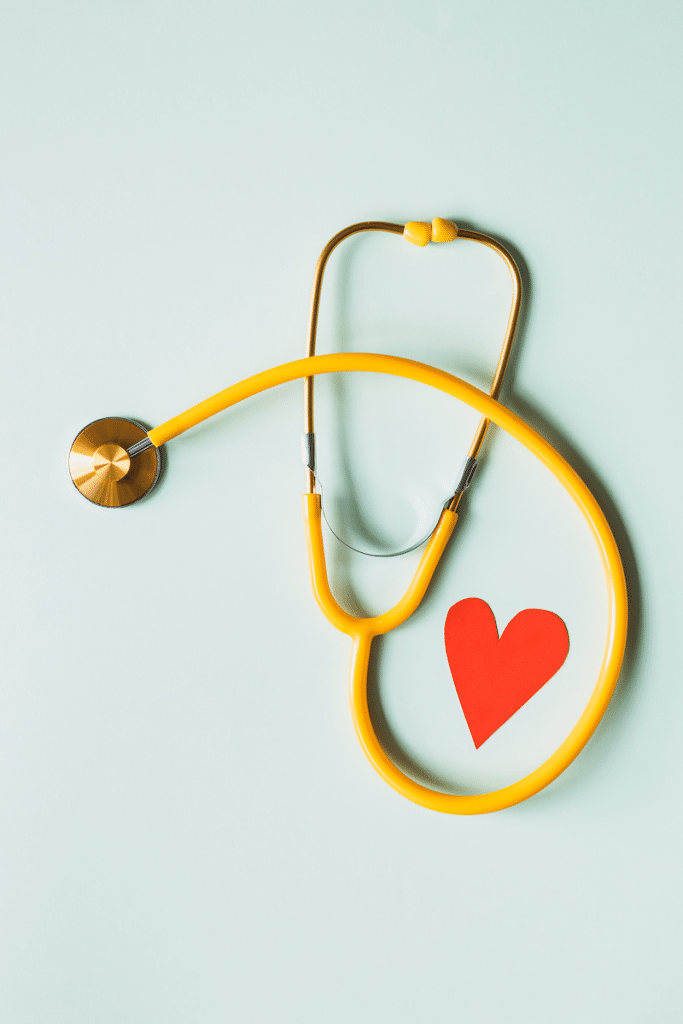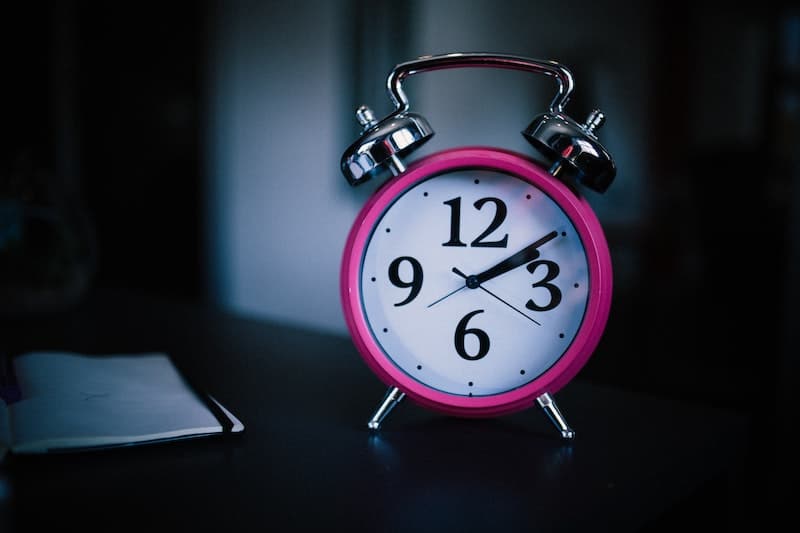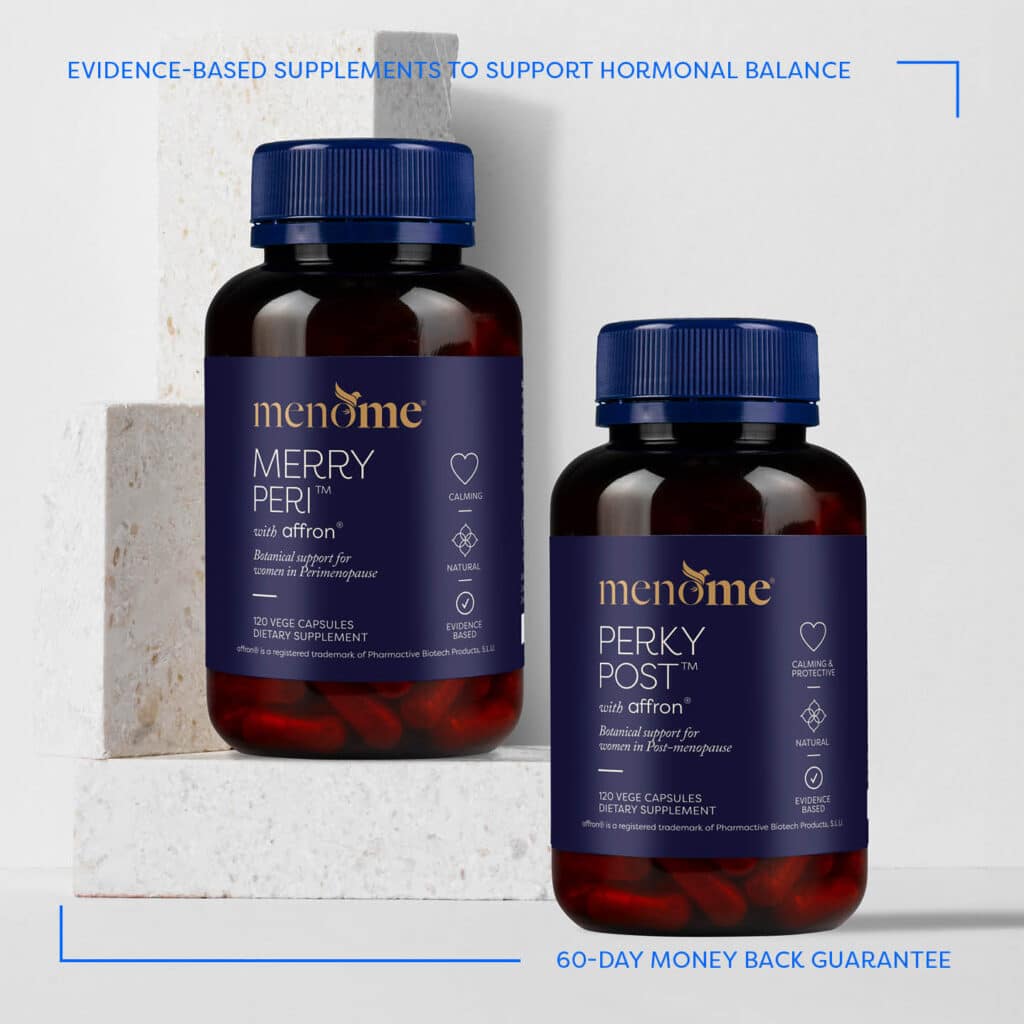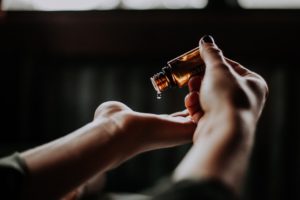7 Natural Solutions To Make Your Menopause Easier: No HRT Required

Hey amazing woman, we’re so glad you dropped by looking for natural alternatives to HRT.
Because if you’re approaching menopause and in pre-, perimenopause or post-menopause* you’re far from alone.
In fact, according to the illustrious World Health Organization:
- worldwide there will be 1.2 billion post-menopausal women by 2030
- 47 million women go through the menopause transition each year
So that’s some pretty big numbers for entering this rollercoaster time, right? And some lucky women will sail through with nary a blip on their radar. But about 80 percent will experience symptoms that are moderate or severe.
Which begs the question: if you’re one of the 80 percent, how do you manage your symptoms?
Well, good news! You’ve come to the right place because we have the incredible Merry Peri™ ( perimenopause support) and Perky Post™ (post-menopause support). They’re natural, evidence-based botanical supplements.
But, with that said, we know you have questions. Such as:
Should you manage menopause naturally or with HRT?

The truth is there’s no one choice because every woman is different.
HRT (also known as MHT) isn’t for everyone. And it’s not safe for every woman (see overview below).
Some doctors also prescribe other forms of medication such as antidepressants to help alleviate symptoms.
As menopause is not a disease but a natural life transition many women choose to avoid medicines. Instead, they opt to manage menopause without HRT.
In fact, the menopause symptoms we’ve normalised in the West are unknown in some cultures, which suggests that lifestyle plays a huge role.
The one non-negotiable is that every woman who goes through menopause comes to the end of her fertile years. And every woman’s experience will be different because we are all same, same but different.
So, there’s no one size fits all.
About the signs and symptoms of menopause
Perimenopause
Most of the years when unwelcome signs occur is during perimenopause. As a result, you may experience hot flushes, mood swings, anxiety, depression, genital, sexual and musculo-skeletal issues.
Perimenopause is when your sex hormones are fluctuating on their way to the time when your ovaries shut up shop. Or, the time when they stop producing eggs.
What can be surprising to many women is that these changes can begin anytime from 35 on.
Post-menopause
Things tend to settle down once you move through into post-menopause. There are no rules, but – on average – this happens at age 51/52. Although it’s sometimes earlier and sometimes later.
It should be noted, and we hate to be the bearers of bad news, but some women can experience signs like hot flushes for years. By the same token, a drier vagina and a change in body shape can be common.
So what’s the lowdown on HRT?
While HRT is great for some, for other women it’s not considered safe.
HRT is not generally recommended* for women with:
- A history of breast or other hormone-dependent cancers although this requires discussion with a specialist. Some of the newer formulations are deemed low-risk
- Experience of blood clots
- Over the age of 60
- Undiagnosed vaginal bleeding
- Liver disease
- History of stroke
For some women HRT can cause:
- breast tenderness
- nausea
- irregular bleeding or spotting
- According to the International Menopause Society, there is a slight risk of stroke or blood clots in the legs or uterus
- They also suggest that combined estrogen and progestogen use may slightly increase breast cancer risk after four/five years
- However, using estrogen alone (for non-risk women) doesn’t increase the likelihood of breast cancer at seven years. But it could do if used for longer
- Additionally, HRT may be good for heart health before age 60 or within 10 years of menopause. But after 60, HRT might slightly increase heart disease risk
7 ways to manage menopause without HRT:
Some women don’t want to go down the medical route and that’s totally fine. You do you. Further – as we’ve discussed – for others it’s simply not the best option.
But never fear, there are options for everyone at the menopause buffet.
Thank you to the Menodoctor for the ‘menopause buffet’ analogy! She shared it on the Women On Fire® podcast we sponsor. You can listen here.
Below are some natural-management steps – they’re not fluff, they’re backed by science.
1. L is for Lifestyle
- Simple changes such as wearing lighter clothing and taking a cool shower or bath before bed may help with hot flushes and night sweats.
- Try not to eat food at least three hours before bed and avoid triggers like caffeine, alcohol (sorry, even that one glass) and spicy food.
- Move on the regular – moderate exercise is good – and attempt to keep your weight on an even keel.
- Ensure you diarise ‘you-time’ and try to get plenty of rest.
- Prioritise being as stress-free as possible. Pop reminders in your phone until it becomes a habit.
- Overhaul your diet. It makes a big difference. BIG. And, if you don’t already, choose fresh fruit and vegetables, lean meats and lots of water wherever possible.
- Avoid sugar, refined carbohydrates and anything from a packet. Yep, the easy, quick gratification stuff!
- Too much sugar and processed foods plus toxins from living can seriously disrupt your sleep.
- This is an amazing time to get serious about your health WOF (warrant of fitness). So, if you haven’t already, stop smoking and reduce alcohol. Not to be killjoys but this will help you to manage symptoms AND support your heart, bones and brain which become pretty vulnerable post-menopause.
2. S is for sleep
Sleep disruption is one of the common bugbears of menopause at every stage. And it can make it super difficult to function well the next day.

It’s incredibly important to try and create a regular sleep schedule even on weekends. As humans, our bodies tend to thrive on routine. So here are some pointers:
- A huge gift we can give you is to suggest you get onto Merry Peri™ ( perimenopause support) or Perky Post™. They both contain affron® saffron, which, after four weeks of use, is associated with wonderful sleep.
- Turn off the lights between 9.30pm and 10pm. According to the ancient wisdom of the Ayurvedic clock the body begins to wind down about 6pm. And from there it prepares for sleep. However, from 10pm to 2pm it begins to repair and renew so it’s best to get to sleep before this kicks in.
- Refer back to Lifestyle Changes above. Prep your bedroom, look at your diet, steer clear of caffeine and alcohol late in the day and stop eating three hours before bed.
- Feast on foods containing tryptophan. Say what?! Yep, it’s a mouthful so let’s explain it. Firstly, it’s pronounced trip-toe-fan and it’s an amino acid that’s a precursor to the neurotransmitter serotonin. Serotonin has been found to play an important role in sleep and mood and high tryptophan foods include chicken, tofu, fish, beans, oats, eggs, nuts and seeds.
- Try supping on a cup of relaxing tea such as chamomile around 6pm. Avoid drinking later so an urge to pee doesn’t ruin your good work.
- A beautiful ritual to avoid phone and computer screens at night is to take a relaxing bath and read before lights out.
For more tips: grab our FREE Sleep Hygiene sheet here.
3. E is for exercise
If you want to down regulate many of the signs and symptoms of menopause move your body. Exercise can help with stress, sleep, weight gain, bone density, memory and mental health. Indeed, it’s a sure-fire wire to calm anxiety. Go for 30-60 minutes daily if you can.
- Cardiovascular exercise such as walking, running, cycling, swimming and HIIT are great. And resistance or weight training should be non-negotiable as it helps to strengthen bones and lessen the risk of osteoporosis. ‘Nuff said.
- If you’re struggling with depression or anxiety movement can be magical. As a result of exercise, the body releases neurochemicals like endorphins, serotonin and dopamine. In turn these chemicals triggers feelings of wellbeing.
- If you only have 10 minutes that’s OK, move your body anyway. It all helps.
- Not a fan of formal exercise? No worries. Simply go for a stroll in nature (which is known as nature bathing), dance or try something new.
- Don’t put the pressure on yourself because the best form of exercise is the one you’ll do. Enjoy!
For more, go see our 7 Wellness Pillars For Your Best Menopause here.
4. Y is for yoga

It’s one of the most ancient practices in the world and it’s been shown to help with menopause symptoms.
In fact, one study1 showed yoga could increase estrogen levels in post-menopausal women. And other research2 explored the positive effects of yoga and sleep in women in midlife. Additionally, another study3 showed that yoga was helpful for both hot flushes and psychological symptoms. So it’s pretty impressive.
For the yoga virgin, the very thought of it can conjure up images of impossibly lithe and flexible people. But the truth is those people are probably long-term devotees. There are many less intense poses that can be achieved by most of us mere mortals – even if you’re arthritic or disabled.
Indeed, yoga incorporates many amazing techniques that are brilliant for managing menopause side effects including breath work, resistance, flexibility and balance.
To clarify, flexibility involves stretching to help keep a good range of motion and fluid joints. On the other hand, balance/coordination like tai chi help us maintain good balance and prevent falls.
What’s more, YouTube is such a fantastic resource and yoga is easily available. Yoga With Adriene has sequences for everyone from beginner to advanced, injured to elderly.
If you’re interested in great alternatives to yoga, try Pilates or tai chi.
5. B is for breathwork & m is for meditation
How many of us remember to breathe properly? Not many and the art is very underrated. Breathing can be used to calm your body in an instant or as a cumulative process. In fact, it can work a little bit like magic.
Indeed, breathing forms the basis of most meditations as it works both physically and emotionally.
Most of us breathe shallowly whereas breathwork uses deep diaphragmatic breathing to help us de-stress and manage anxiety, calm ourselves to sleep or process a hot flush.
A study in the Menopause4 journal showed slow, deep, diaphragmatic breathing (which they call paced breathing) helps with meno symptoms.
For anxiety and panic attacks 4-7-8 breathing is our go-to.
Here’s how:
- Breathe out and release all breath in the lungs
- Breathe in for four
- Hold for seven
- Breathe out for eight
- Repeat
6. CBT is for cognitive behavioural therapy
Several studies have shown that cognitive behavioural therapy (CBT) is super helpful for managing menopause symptoms.
It works to help you understand how what you think, feel, behave and your physical reactions connect together. Additionally, it also helps you develop coping skills to manage them i.e. helping you reframe negative thoughts around having a hot flush.
Research has shown that including CBT in your natural menopause management is helpful for hot flushes and night sweats. And ongoing studies are pointing to its benefits with anxiety, depression and sleep.
7. AS is for appropriate supplementation
At MenoMe® our philosophy is all about the holistic, evidence-based management of menopause.
It’s what lights us up and we’re very aware of the wisdom of Mother Nature.
That’s why we created Merry Peri™ and Perky Post™ to be your peri and post-menopause wing women. They’re natural, they’re evidence-based – you’ll find the ingredients in your kitchen – and they come with a money-back guarantee. So if you don’t love them you’ll get a no-questions-asked refund. How good is that?
Want to know more: read What You Need To Know About Merry Peri™ and Perky Post™.
Conclusion
We hope these words have shown you ways you can support you menopause naturally without HRT.
Indeed, choosing from the menopause buffet provides a multi-pronged approach for navigating the meno rollercoaster. So you can win the game! 🙂
Share with a friend
Sign up to our mailing list for the latest news and stories and receive a $5 discount code to redeem on your first purchase, plus receive a 3 step eBook on ways to support your body through menopause…
This site is protected by reCAPTCHA and the Google Privacy Policy and Terms of Service apply.
Related Articles
Disclaimer
*We refer to natural pre-, peri- and post-menopause not surgically induced menopause.
Our articles are a guideline only and should not take the place of medical advice. Any signs and symptoms you are experiencing could be due to a number of reasons. If you’re experiencing ongoing signs please see your health professional.
- https://journals.lww.com/menopausejournal/Abstract/2016/05000/Yoga_increased_serum_estrogen_levels_in.18.aspx
- https://pubmed.ncbi.nlm.nih.gov/27707450/
- https://pubmed.ncbi.nlm.nih.gov/28917368/
- https://journals.lww.com/menopausejournal/Abstract/2013/02000/Paced_breathing_compared_with_usual_breathing_for.12.aspx
- https://pubmed.ncbi.nlm.nih.gov/22947108/










